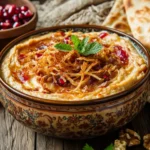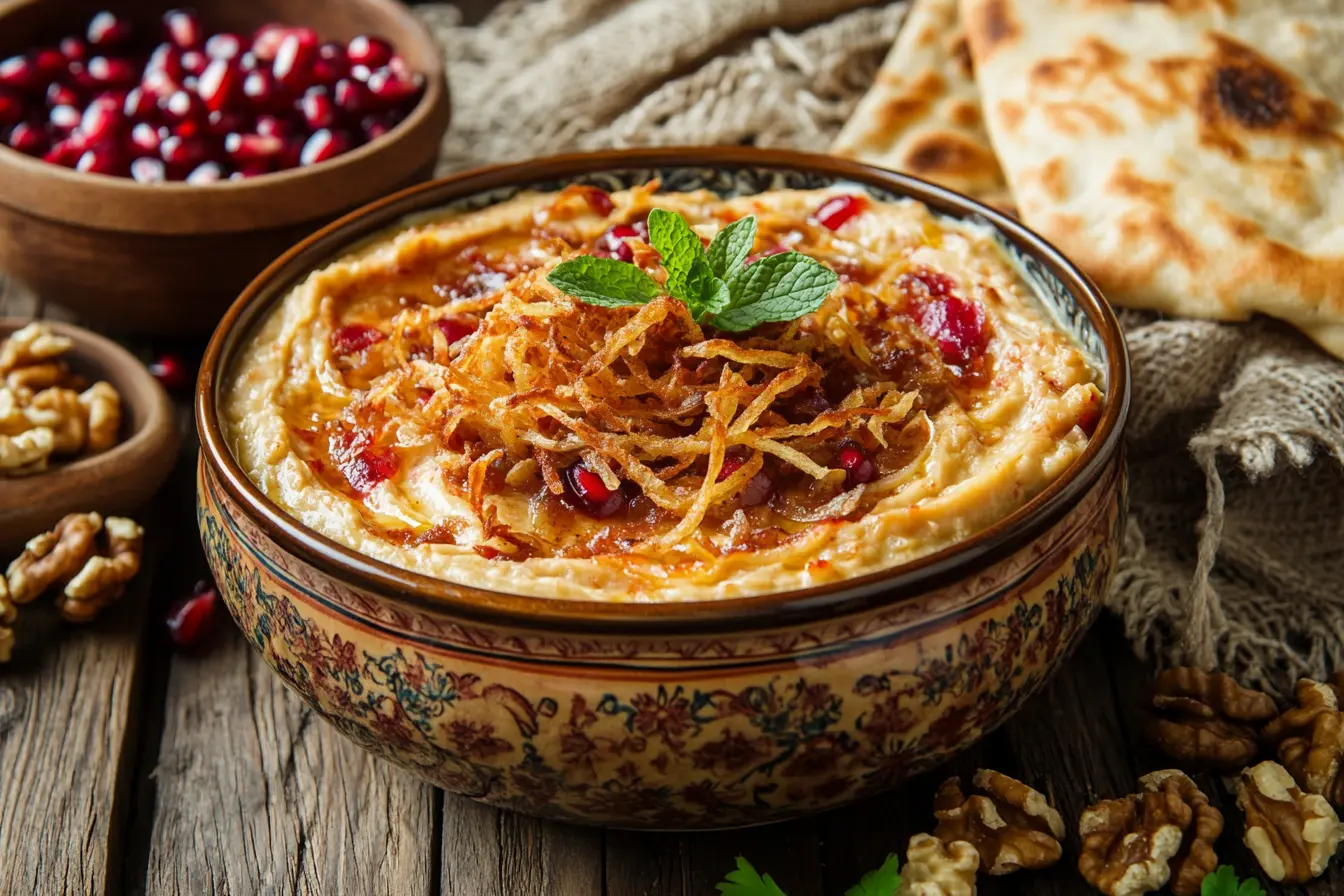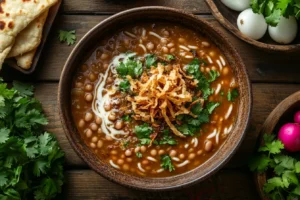Persian cuisine is a treasure trove of rich flavors, unique ingredients, and centuries-old traditions. Every dish tells a story, combining sweet, sour, and savory notes in perfect harmony. From hearty stews to crispy rice, this cuisine offers something for everyone. Whether you’re curious about its history or eager to try your hand at making these dishes, this guide will take you through the essentials of Persian recipes.
Introduction to Persian Cuisine
The Rich History of Persian Culinary Traditions
How Persian Recipes Evolved Over Time
Persian cuisine has a history that stretches back thousands of years. Ancient Persia, with its vast empire, welcomed ingredients and cooking methods from places like India, Greece, and Central Asia. These influences blended seamlessly, creating the flavorful and aromatic dishes we know today.
Over time, Persian food became known for its balance. Traditional Persian recipes often pair contrasting tastes, like sweet pomegranate syrup with the tang of yogurt or savory meats with floral saffron rice. This harmony is a hallmark of Persian cooking that has endured for centuries.
The Role of Geography and Culture
Persia’s diverse landscape has shaped its food in remarkable ways. Fertile plains supply fresh fruits and nuts, while cooler mountains grow herbs and spices. The Mediterranean-like climate allows pomegranates, pistachios, and saffron to thrive.
Culturally, food is central to Persian life. Meals are often shared with family and friends, with dishes designed to be both satisfying and beautiful. A typical Persian meal is more than just food—it’s a celebration of connection and tradition.
Key Ingredients in Persian Cooking
Herbs and Spices: The Soul of Persian Cuisine
Fresh herbs like parsley, mint, and cilantro feature prominently in Persian recipes. Spices such as saffron, turmeric, and cinnamon add depth and warmth. Among them, saffron stands out as a prized ingredient, lending its golden color and delicate aroma to many dishes.
Everyday Staples: Rice, Bread, and Legumes
Rice is the star of many Persian meals. Whether served with crispy Tahdig or mixed with fragrant herbs, it’s a must-have. Traditional breads like lavash and sangak often accompany meals, while lentils and chickpeas bring a hearty touch to soups and stews.
Persian Appetizers and Side Dishes
Popular Persian Starters
Persian cuisine shines with its appetizers, offering light yet flavorful options that prepare the palate for a delightful meal. These dishes not only highlight the creativity of Persian recipes but also bring a refreshing balance to the table. Whether you’re enjoying a casual gathering or a formal dinner, Persian starters always make an impression.
Mast-o-Khiar (Yogurt and Cucumber Dip)
Mast-o-Khiar is a classic Persian appetizer that’s both creamy and cooling. Made with thick yogurt, finely chopped cucumbers, and a touch of dried mint, it’s incredibly simple to prepare. Additionally, its flavor can be elevated by adding fresh dill, raisins, or crushed walnuts.
Typically served with soft lavash bread or crunchy vegetable slices, Mast-o-Khiar is as versatile as it is delicious. Moreover, it’s packed with probiotics, which makes it not only tasty but also great for digestion. For anyone looking to start their meal with a light yet satisfying dish, this one never disappoints.
Kashk-e Bademjan (Eggplant Dip)
Kashk-e Bademjan is another beloved appetizer in Persian cuisine. Made with roasted eggplant, garlic, caramelized onions, and a drizzle of kashk (fermented whey) or yogurt, this dip is rich and savory. What makes it even more enticing is the smoky flavor of the eggplant, which pairs beautifully with the tangy topping.
Typically, Kashk-e Bademjan is served warm and enjoyed with freshly baked bread. Because it’s hearty and nutrient-dense, it often doubles as a light meal on its own. For anyone trying Persian recipes for the first time, this dish offers a perfect introduction to bold and unique flavors.
Fresh Herb Platters (Sabzi Khordan)
Sabzi Khordan is a simple yet essential part of Persian meals. This vibrant platter features fresh herbs such as parsley, mint, and cilantro. Often accompanied by crunchy radishes, scallions, and walnuts, it adds freshness to any meal.
Persian families often serve Sabzi Khordan alongside bread and feta cheese for a balanced and refreshing side. Not only does it cleanse the palate, but it also complements the heavier main dishes perfectly. Every bite reminds you of the importance of freshness in Persian recipes.
If you enjoy experimenting with dips and spreads, you might also like our recipe for Pretzel Cheese Dip for a modern twist on traditional starters.
Signature Persian Main Courses
Iconic Persian Dishes That Reflect Tradition and Flavor
Persian main courses bring bold flavors and cultural significance to the table. These dishes highlight the care and creativity behind Persian recipes, combining fresh ingredients with simple techniques. From fragrant stews to grilled kebabs, each dish tells a story of heritage and hospitality.
Ghormeh Sabzi (Herb Stew)
Ghormeh Sabzi stands as a shining example of Persian cooking. This flavorful herb stew uses fresh parsley, cilantro, and fenugreek to create a vibrant base. To make it hearty, cooks add tender chunks of lamb or beef along with red kidney beans. Additionally, dried limes give the dish its signature tangy flavor, making every bite exciting.
When preparing Ghormeh Sabzi, you begin by sautéing the herbs until their fragrance fills the kitchen. This step intensifies the flavors and sets the tone for the entire dish. As it simmers, the ingredients blend beautifully, creating a rich and satisfying stew. Paired with basmati rice, Ghormeh Sabzi transforms a simple meal into a memorable experience.
Fesenjan (Pomegranate Walnut Stew)
Fesenjan showcases the elegance of Persian recipes. Cooks prepare this dish by simmering ground walnuts with pomegranate molasses, creating a velvety sauce that balances sweet and tart flavors. They typically pair it with chicken or duck, allowing the meat to absorb the luxurious sauce.
The slow cooking process helps the ingredients meld, enhancing both the flavor and texture of the stew. The walnuts add a creamy consistency, while the pomegranate molasses contributes a bold tang that brightens the dish. Whether for a festive occasion or a casual meal, Fesenjan brings sophistication to any table.
Persian Kebab Varieties
Chelo Kebab (Rice with Grilled Meat)
Chelo Kebab stands out as one of the most popular Persian dishes. Juicy skewers of lamb, chicken, or beef are grilled to perfection, and cooks serve them alongside fluffy basmati rice. Saffron butter melts into the rice, giving it a golden color and a rich aroma.
Grilled tomatoes and fresh herbs accompany the kebabs, adding refreshing flavors to the smoky meat. Chelo Kebab exemplifies how Persian recipes turn simple ingredients into something extraordinary, making it a staple in Persian households.
For those intrigued by rich and hearty dishes, check out our smoky chicken tomato bisque recipe that offers a comforting and flavorful experience.
Persian Rice Dishes: The Heart of Persian Cuisine
Persian rice dishes are much more than a side; they are the centerpiece of many meals. Their fragrant aromas, fluffy textures, and intricate preparation techniques demonstrate the artistry of Persian recipes. Whether paired with crispy Tahdig or mixed with herbs and spices, Persian rice consistently elevates any table.
The Art of Persian Rice Cooking
Creating Tahdig (Crispy Rice)
Tahdig, the golden, crispy layer of rice at the bottom of the pot, is a cherished highlight of Persian meals. To make it, cooks rinse rice to remove excess starch, ensuring the grains stay light and fluffy. They then layer it in a pot with oil, butter, or yogurt, letting it cook slowly until the bottom turns crispy and golden.
When the pot is flipped, Tahdig emerges as the showpiece of the meal, with its crunch adding texture and excitement. Families often savor Tahdig first, treating it as a prize that reflects the cook’s skill and care.
Polo: Flavored and Mixed Rice Dishes
Persian cuisine offers countless variations of Polo, where rice combines with herbs, fruits, or spices. For instance, Sabzi Polo features dill, parsley, and cilantro, creating a fresh and aromatic dish that pairs perfectly with fish. On the other hand, Zereshk Polo blends rice with tangy barberries and saffron, delivering a bold, vibrant flavor.
Each Polo dish is layered carefully, ensuring the flavors meld beautifully with every bite. These dishes highlight how Persian recipes turn simple ingredients into extraordinary creations.
Persian Soups and Stews: Comfort in Every Bite
Persian soups and stews are a cornerstone of the cuisine, offering hearty, flavorful meals that feel like a warm hug. These dishes combine simple ingredients with rich flavors, making them an essential part of Persian recipes. Whether you’re enjoying a herb-packed soup or a savory stew, every spoonful reflects the love and care of Persian cooking.
Traditional Persian Soups
Ash Reshteh (Noodle and Bean Soup)
Ash Reshteh stands out as one of the most loved Persian soups. Packed with beans, lentils, noodles, and fresh herbs, it’s as nourishing as it is tasty. Many cooks finish it with kashk (fermented whey) and crispy onions, adding a creamy texture and extra flavor.
To prepare this soup, you first simmer the beans and lentils until tender. Then, fresh herbs like parsley, cilantro, and spinach are added, giving it a bright and earthy taste. Finally, noodles are cooked gently to retain their texture. Ash Reshteh is more than a dish—it’s a symbol of warmth and tradition, perfect for any gathering.
Savory Persian Stews
Khoresht-e Bademjan (Eggplant Stew)
Khoresht-e Bademjan is a rich and satisfying stew that highlights eggplant as the star ingredient. Cooks combine tender eggplants with tomatoes, onions, and meat, like lamb or beef, to create a stew full of flavor.
The ingredients simmer slowly, allowing their flavors to blend beautifully. Spices like turmeric and saffron give the dish warmth and depth, while the eggplant absorbs all the savory goodness. Served over basmati rice, Khoresht-e Bademjan is a true example of how Persian recipes transform simple ingredients into extraordinary meals.
Persian Desserts and Sweets: A Taste of Tradition
Persian desserts add a delightful ending to every meal, blending subtle sweetness with fragrant spices and floral notes. Known for their elegance and unique ingredients, these treats are an essential part of Persian recipes. Whether it’s a creamy pudding or a flaky pastry, Persian desserts always bring a sense of celebration and tradition to the table.
Classic Persian Sweets
Sholeh Zard (Saffron Rice Pudding)
Sholeh Zard is one of the most beloved Persian desserts, known for its vibrant color and delicate flavor. Cooks prepare this dish using rice, saffron, sugar, and rosewater, which gives it a creamy texture and a fragrant aroma. To make it even more special, they often decorate it with cinnamon, slivered almonds, or pistachios.
The process begins with simmering rice until it becomes soft, which ensures the pudding’s smooth consistency. Then, saffron and sugar are added, giving it a rich, golden hue and just the right amount of sweetness. Sholeh Zard often appears at celebrations and special events, making it a dish that truly captures the spirit of Persian recipes.
Baklava
Persian baklava is a dessert that takes sweetness to another level with its layers of flaky pastry and nutty filling. While baklava is popular in many cultures, the Persian version stands out thanks to its use of rosewater and cardamom, which give it a distinct and aromatic flavor.
To make baklava, cooks carefully layer thin sheets of dough with a mixture of ground nuts and bake it until golden brown. Once it comes out of the oven, they pour rosewater-infused syrup over the warm pastry, allowing the layers to soak up the sweetness. Every bite delivers a perfect crunch, balanced by the fragrant syrup, making Persian baklava a true delight.
Fans of Persian desserts might also enjoy our banana bread recipe without butter for a healthier take on a classic treat.
Persian Tea Culture
Tea, or “chai,” is an integral part of Persian life, often served alongside desserts. Brewed strong and rich, Persian tea is poured into small glasses and enjoyed slowly. It’s usually accompanied by rock candy or sugar cubes for a touch of sweetness. Moreover, tea represents hospitality in Persian homes, making it more than just a drink—it’s a tradition that brings people together.
FAQs and Nutritional Information About Persian Recipes
Persian cuisine is as nourishing as it is delicious. Its use of fresh ingredients, vibrant spices, and traditional cooking methods makes it both satisfying and wholesome. In this section, we’ll answer some common questions about Persian recipes and explore their nutritional benefits, along with tips for adapting them to different dietary needs.
Frequently Asked Questions About Persian Recipes
What are the key spices in Persian recipes?
Persian cuisine relies heavily on aromatic spices to create its signature flavors. Saffron, turmeric, cinnamon, and sumac are among the most common. These spices not only enhance the taste of dishes but also add vibrant colors and health benefits.
How is Persian rice different from other rice dishes?
Persian rice stands out because of its light, fluffy texture and unique cooking methods. Techniques like rinsing the rice and steaming it ensure each grain stays separate. Additionally, the crispy layer of Tahdig sets Persian rice apart, making it a must-try element of Persian recipes.
Are Persian dishes usually spicy?
Unlike many Middle Eastern cuisines, Persian food focuses on aromatic flavors rather than intense heat. While spices like turmeric and cinnamon add warmth, Persian dishes rarely include chili peppers or overly spicy ingredients.
Can Persian recipes be made vegetarian or vegan?
Absolutely! Many Persian dishes already use plant-based ingredients, such as Sabzi Polo, Ash Reshteh, and Kashk-e Bademjan. For stews like Fesenjan or Khoresht-e Bademjan, you can replace meat with tofu or additional vegetables for a vegetarian-friendly option.
Why is saffron so important in Persian cuisine?
Saffron, often called “red gold,” plays a central role in Persian recipes because of its unique aroma, flavor, and color. It is used in rice dishes, desserts, and even stews, making it an irreplaceable ingredient in Persian cooking.
What are some classic Persian desserts?
Persian desserts include sweet and fragrant options like Sholeh Zard (saffron rice pudding), Baklava, and Ranginak (date-filled pastry). These treats often incorporate rosewater, cardamom, and nuts for a luxurious finish.
Nutritional Information and Considerations
Health Benefits of Persian Ingredients
Persian recipes use many wholesome ingredients, such as herbs, legumes, and lean proteins. Ingredients like saffron and turmeric have anti-inflammatory properties, while fresh vegetables provide essential vitamins. Even sweet dishes often include nuts, which add protein and healthy fats.
Tips for Healthier Persian Recipes
To make Persian recipes even healthier, consider using less oil in stews or grilling meats instead of frying them. You can also add more vegetables to your rice dishes and soups for added fiber. If you want to reduce sugar in desserts, honey or natural sweeteners can make excellent substitutes.
Conclusion
Persian recipes are more than just meals; they are a celebration of history, culture, and the joy of sharing food. With their harmonious balance of flavors, aromatic spices, and vibrant ingredients, these dishes create unforgettable dining experiences. From crispy Tahdig to sweet Sholeh Zard, every bite reflects the care and creativity that define Persian cuisine.
Whether you’re exploring hearty stews, aromatic rice dishes, or delicate desserts, Persian food offers something for everyone. It brings people together, honoring traditions while remaining versatile enough to adapt to modern tastes. By trying your hand at Persian cooking, you’re not only preparing a meal but also connecting with a rich culinary heritage that has delighted generations.
So, gather your ingredients, embrace the warmth of saffron and rosewater, and let Persian recipes transform your kitchen into a place of flavor, culture, and love.
Print
Exploring Traditional Persian Recipes: A Culinary Journey Through Flavors and Culture
- Total Time: 1 hour
- Yield: 4 servings 1x
Description
A creamy Persian eggplant dip with smoky flavors, enhanced by caramelized onions and tangy kashk (fermented whey).
Ingredients
- 2 large eggplants
- 2 medium onions, thinly sliced
- 3 cloves garlic, minced
- 1/4 cup kashk (or Greek yogurt as a substitute)
- 1/4 tsp turmeric
- 1/4 tsp black pepper
- 1/4 tsp salt (adjust to taste)
- 3 tbsp olive oil
- 2 tbsp walnuts, crushed (optional for garnish)
- 1 tsp dried mint
- Fresh parsley for garnish
Instructions
- Preheat the oven to 375°F (190°C). Roast the eggplants until soft and their skins are charred, about 35–40 minutes. Once cool, peel the skins and mash the flesh.
- Heat olive oil in a pan over medium heat. Add sliced onions and sauté until caramelized, about 10 minutes. Set aside half for garnish.
- Add garlic to the pan and sauté for 1 minute. Stir in turmeric, then add the mashed eggplants. Cook for 5–7 minutes.
- Mix in the kashk (or yogurt) and stir well. Adjust seasoning with salt and pepper.
- Transfer the mixture to a serving dish and garnish with caramelized onions, walnuts, dried mint, and fresh parsley. Serve warm with bread.
- Prep Time: 10 minutes
- Cook Time: 50 minutes
- Category: Appetizer
- Method: Sautéing and roasting
- Cuisine: Persian
Nutrition
- Serving Size: Per Serving
- Calories: 180
- Sugar: 6g
- Sodium: 230mg
- Fat: 12g
- Carbohydrates: 15g
- Fiber: 4g
- Protein: 4g
Keywords: Iranian recipes, traditional Persian cuisine, authentic Persian cooking, Persian dishes, Middle Eastern food, saffron recipes.


